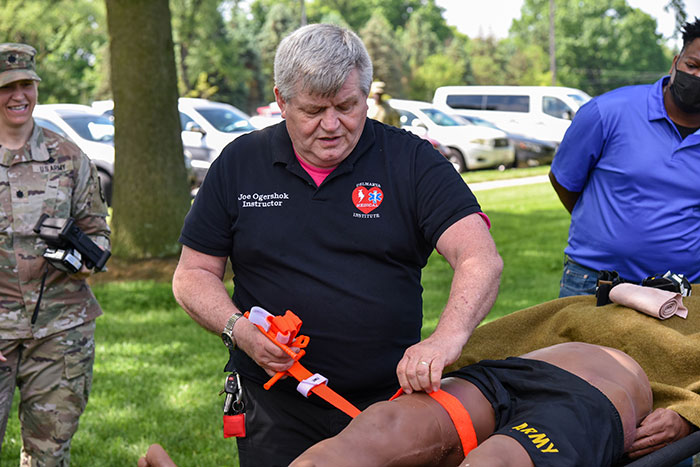'Stop the Bleed' Event: Focus on Simple Skills, Saving Lives

The U.S. Army Medical Research and Development Command held its second-ever National STOP THE BLEED® Day awareness event at Fort Detrick on May 19. The event, which took place on Blue and Gray Field, was designed to teach USAMRDC Soldiers, civilian employees and contractors how to properly respond to instances of traumatic bleeding in everyday situations.
In all, more than 40 attendees received hands-on instruction in basic wound packing techniques and proper tourniquet application from USAMRDC Service Members and other associated medical experts.
"It's hard to imagine a life-saving intervention more simple and impactful as applying a tourniquet," said Lt. Col. Melinda Hamer, deputy director of operations at USAMRDC's Congressionally Directed Medical Research Programs, who spoke briefly to attendees at the event's morning session regarding the importance of knowing how to spot, assess and provide aid during a bleeding emergency.
The STOP THE BLEED® campaign was initially developed at USAMRDC's Combat Casualty Care Research Program in 2015 as part of a cooperative effort with the U.S. National Security Council and the American College of Surgeons; who were seeking a way to build national resiliency in the wake of a series of then-recent mass trauma incidents, including – most notably – the Boston Marathon bombing in 2013. The campaign focuses chiefly on the use of tourniquets, modern versions of which have been both developed by the U.S. military and used by Warfighters in innumerable combat scenarios. The campaign was officially launched at the White House in October 2015.
"If you call EMS for help, it's going to take them an average of six minutes to get to you – but it can take only three minutes to bleed out," said Joe Ogershok, head medical trainer at USAMRDC and a STOP THE BLEED® instructor, supplying perspective to attendees during an afternoon training session. "Your goal is to keep the bleeding victim alive so that once professional help does arrive, that person can then be treated on scene." The training portion of the event allowed attendees to practice tourniquet application techniques on electronic, life-like manikins which were, in turn, connected to a water supply in order to simulate the sizable amount of blood associated with a bleeding emergency. During a practice event focused on wound packing, trainers preached the importance of finding the source of the wound as early as possible, using clean gauze to insert into said wound and then – if possible – placing pressure on the wound to slow overall blood loss.
"Using one of those electronic manikins – it's an intense and interesting experience," said Allen Rawls, a logistician working with G4 in the Equipment Management Division. "It's a great experience and I'm glad I got the opportunity to learn these skills."
"I did this back in 2019, so I wanted to come back and refresh my skills," said Pamela Doring, USAMRDC internal review chief, referencing the first iteration of the event at the command. "I wanted to test my skills on one of those electronic manikins, to see how I did."
Since its launch, the STOP THE BLEED® campaign has been licensed to more than 460 public and private entities across the globe, including partnerships with various U.S. state and municipal governments, local and national hospital systems, medical supply manufacturers, community groups, police and fire departments and professional sports teams, among other organizations.
To access virtual STOP THE BLEED® training sessions developed by the American College of Surgeons, a key campaign partner, visit: stopthebleed.org. For information about the campaign itself and the many ways to get involved, go to stopthebleedproject.org.














